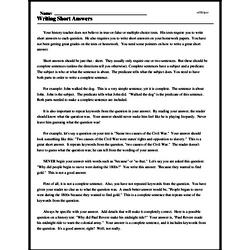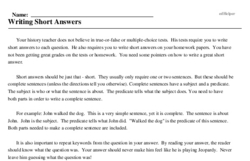Writing Short Answers
Your history teacher does not believe in true-or-false or multiple-choice tests. His tests require you to write short answers to each question. He also requires you to write short answers on your homework papers. You have not been getting great grades on the tests or homework. You need some pointers on how to write a great short answer.
Short answers should be just that - short. They usually only require one or two sentences. But these should be complete sentences (unless the directions tell you otherwise). Complete sentences have a subject and a predicate. The subject is who or what the sentence is about. The predicate tells what the subject does. You need to have both parts in order to write a complete sentence.
For example: John walked the dog. This is a very simple sentence, yet it is complete. The sentence is about John. John is the subject. The predicate tells what John did. "Walked the dog" is the predicate of this sentence. Both parts needed to make a complete sentence are included.
It is also important to repeat keywords from the question in your answer. By reading your answer, the reader should know what the question was. Your answer should never make him feel like he is playing Jeopardy. Never leave him guessing what the question was!
For example, let's say a question on your test is "Name two causes of the Civil War." Your answer should look something like this: "Two causes of the Civil War were states' rights and opposition to slavery." This is a great short answer. It repeats keywords from the question, "two causes of the Civil War." The reader doesn't have to guess what the question was; he can tell from the wording of your answer.




